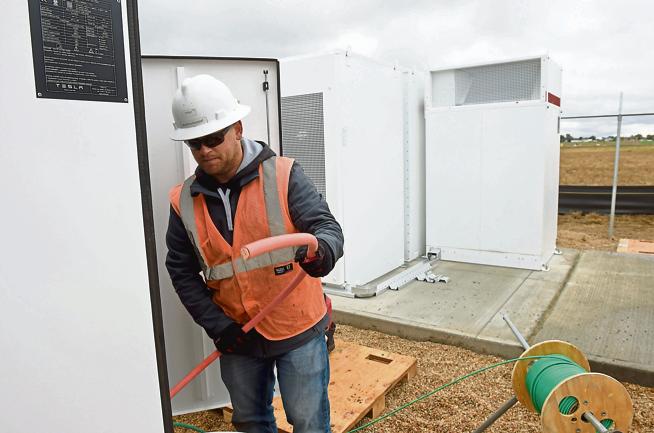
United Power officials hope the largest lithium ion battery in Colorado — being installed now just east of Longmont — will pay big benefits to both company and household bottom lines, as well as help it harness renewable energy in a reliable and dependable manner. If it does, it could serve as a model for other providers looking to increase the power they generate from non-fossil fuel sources.
The battery when it is brought onto the grid early next month could save United Power as much as $1 million annually by storing energy that would otherwise go waste.
Being supplied by California-based automotive and energy giant Tesla, the battery will have a storage capacity of four megawatts — enough to simultaneously power 600 to 700 homes, United Power New Energy Director Jerry Marizza said.
The battery will save money — about $80,000 a month, Marizza predicts — by capturing energy generated on United’s grid overnight and saving it for distribution during periods of peak demand in afternoons, when power is more expensive to supply and thus, for residential customers, pricier to consume.
United Power is a Brighton-based cooperative owned by its customers and serves a 900-square-mile area north of Denver that includes Firestone, Frederick, Dacono, Mead and parts of Erie and Broomfield.
Battery storage technology is crucial to enhance the practicality of relying on renewable energy sources as an alternative to fossil fuels, Marizza said.
“This is the next logical step for renewable generation,” he said. “For it to continue to be a success story, integrating this storage component is absolutely critical for the continuance of renewable generation. This is our first big step into that world, we’re going to learn a lot about the battery, where it’s good, where it’s bad.”
The battery, being installed at United’s western facility along Interstate 25 just south of Colo. 119, is not being hooked up solely to a solar panel field, but will store power generated from all sources on United’s grid.
Lithium ion batteries hooked to solar panel fields would be on the opposite schedule as United’s — storing energy captured in the daytime for distribution at night.
“Honestly, I think people will continue to want to watch television at night. So having a way to store solar energy during the day and releasing it at night is critical to get anywhere close to what these politicians are talking about as far as a high percentage of renewables in their area,” Marizza said.
Officials with Platte River Power Authority, which provides wholesale power to Longmont, Loveland, Fort Collins and Estes Park, will be monitoring the performance of United’s new battery.
“We try our best to watch all these emerging technologies,” Platte River spokesman Steve Roalstad said. “… It’s important to study this stuff not only at a large level, but also at a distribution level, because batteries perform differently depending on their source, and they could perform different at the distribution and utility levels. We may need to deploy these on a widespread basis.”
The Sierra Club earlier this year criticized a Platte River Power study suggesting a zero-net carbon model of power generation would be more feasible than a fully renewable model by 2030, with the environmental group saying the utility did not account for the increasing capability of battery storage technology.
City councils in Longmont and Fort Collins in the past year have committed to having 100 percent of their power supply come from renewable sources by 2030.
At its new headquarters being built in Fort Collins and scheduled to open in 2020, Platte River will be using the same technology for a smaller battery that will function on a distributional level — as opposed to the high-voltage utility transmission use United Power’s is geared toward.
Platte River also is building a 20 megawatt solar field at its Rawhide site north of Wellington that will have a smaller battery component in the one- or two-megawatt range and will be finished in 2021.
Work on the United Power battery — which was contracted to Chicago-based SoCore Energy — is expected to finish by Oct. 22 and be ready for inspection by Tesla officials at the end of the month, and will be brought online by the first week of November.
The total cost of the battery project to United Power was not immediately available Monday afternoon.
“Community batteries allow co-ops and their members to address the demand components of the utility bill — the portion that can’t easily be addressed with solar energy alone. Batteries provide opportunities to reduce costs, increase choices for co-ops and their members while improving resiliency of the grid,” Rob Scheuermann, president of SoCore Energy, which was bought by France-based Engie this year, said last year in a press release announcing the battery project last year.
